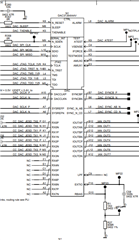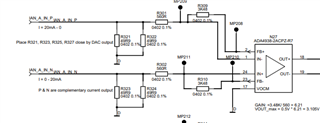We are using the DAC37J84 as a programmable waveform generator. The full-scale current is set up as 0.02073 A (Rbias = 1.91kOhm, course_dac = 10). The load resistors on IOUTP and IOUTN are each 24.95 ohms. For test purposes, the outputs are not connected to any other circuit.
When we program full-scale output, I expect 0.517 volts (0.02073 A * 24.95 ohms) on one pin and 0.000 (0.0000 A * 24.95 ohms) on the other. We actually measure 0.594 V (15% error) and 0.077 V (infinite error). It's as though there is an extra 3 mA flowing in both outputs.
Where does this offset come from? Is it explained somewhere in the data sheet (SLASE17B)? I could find no mention.



